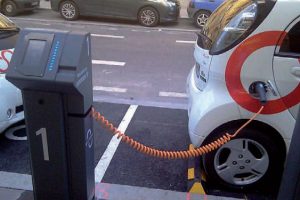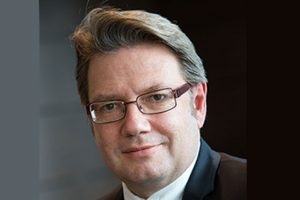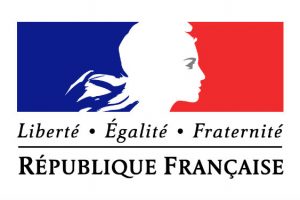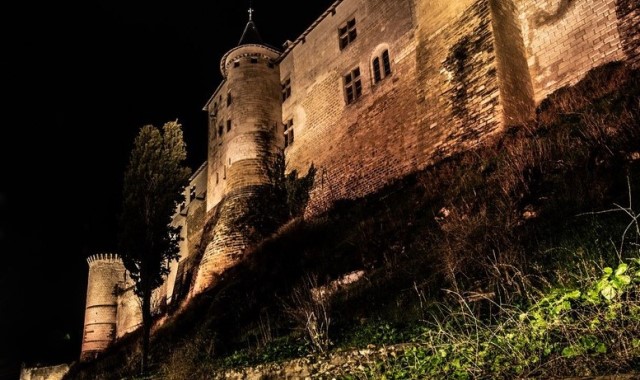
En 2016, le conseil général d’Indre-et-Loire décide de rénover l’éclairage de la forteresse royale et fait appel à Christophe Canadell, agence Noctabene, et Pascal Gougeon, Atelier Kandela. Les deux concepteurs lumière s’associent pour offrir un double regard sur le patrimoine architectural chinonais en s’inspirant de l’histoire du site. Ils imprègnent ainsi de poésie la scénographie lumière qui s’exprime sur l’ensemble de la forteresse royale.
In 2016, the General Council of Indre-et-Loire decided to renovate the lighting of the royal fortress and called upon Christophe Canadell of Noctabene and Pascal Gougeon of Atelier Kandela. The lighting designers who teamed up to offer a twin vision on Chinon’s architectural heritage, inspired by the history of the site. They thus impregnate with poetry the lighting scenography that is expressed throughout the royal fortresse. (English below)
La Forteresse royale de Chinon, propriété du conseil départemental d’Indre-et-Loire, est située sur un promontoire naturel dominant la Vienne et la ville de Chinon. Elle acquiert sa configuration définitive au temps de Charles VII ; elle est classée monument historique en 1840. Du pont qui traverse la Vienne aux étroits passages de la vieille ville, les rues de Chinon ramènent immanquablement au pied de la forteresse, comme autant d’invitations à découvrir les charmes de ce site classé au patrimoine mondial de l’humanité par l’Unesco.
Un pas de deux
Christophe Canadell (agence Noctabene) et Pascal Gougeon, (Atelier Kandela) se connaissent bien et travaillent la lumière dans un esprit de sobriété et de douceur. « Nous avons la même approche du concept lumineux du site : pas de couleurs criardes ni d’effets bling-bling ! », précise Christophe Canadell. Le contexte s’y prête d’ailleurs tout à fait : pas moins de trois architectes veillent à la préservation du patrimoine… Les deux concepteurs conduisent chacun une réflexion puis confrontent leurs idées sur cette mise en lumière atypique qui ne laisse pas beaucoup de liberté quant à l’implantation du matériel. Leurs échanges enrichissent l’étude et le projet se dessine pour définir un éclairage en contre-plongée sur toutes les façades du site. Mais les contrebas du rocher sont recouverts d’arbustes qui cachent les murailles de l’édifice. Grâce à la mise en place d’un écopâturage, les flancs de la forteresse sont « nettoyés » de cette végétation et la mise en lumière peut se réaliser. Une autre difficulté surgit : l’architecte des bâtiments de France souhaite que la lumière vienne d’en haut. « Compte tenu de la configuration du lieu et de la nature du bâtiment, il nous était difficile d’implanter le matériel sur les murs eux-mêmes. Travailler en duo nous a permis d’être force de persuasion. Nous avons su trouver les arguments pour justifier notre choix et un éclairage du bas vers le haut a été adopté », souligne Pascal Gougeon.

Un éclairage en contre-plongée sur mâts
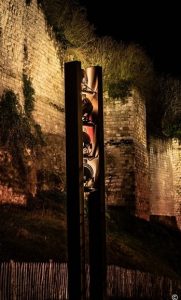
La question de la typologie du matériel restait entière. Hors de question de positionner des projecteurs sur la pierre : trop visible et trop de risque de lumière perdue. Les concepteurs trouvent la solution dans la création d’un totem supportant plusieurs projecteurs (Lumenpulse). « Ces mâts-totems nous ont permis d’éclairer également le muret. Ils ont été dimensionnés sur mesure, de 1,50 m à 7 m de hauteur, et comprennent de trois à neuf projecteurs selon les zones à éclairer », explique Christophe Canadell. Cette disposition souligne les reliefs et les spécificités de la forteresse qui restaient invisibles jusqu’alors. Camila Le Bertre (chef de projet, Noctabene) s’est chargée de la mise au point technique des totems. Ils ont été fabriqués par GHM et édités dans une couleur « acier Corten » qui permet de les fondre dans le paysage. Ils ont été implantés, côté sud, sur l’emplacement des mâts de l’ancienne installation d’éclairage, ainsi que sur le chemin de halage et autour de la forteresse pour les faces ouest, est et nord. « Nous avons prévu une technique en RVB afin de laisser la possibilité au château de jouer sur la couleur. Nous avons conçu l’éclairage de base en blanc chaud pour le haut de la muraille ; la couleur n’est utilisée que sur l’embase et les changements de couleur n’interviennent que sur cette zone : rouge ambré pour les fêtes médiévales et bleu à Noël », ajoute Pascal Gougeon.
Rétro-éclairage et balisage au château
Dans certains espaces de la forteresse de Chinon, tels que la tour de l’Horloge, la tour des Chiens et les logis royaux, des réglettes LED attirent l’attention des visiteurs sur de nombreux détails architecturaux. Des bancs rétro-éclairés et intégrant un système de sonorisation pour les parcours touristiques ont été implantés pour offrir aux touristes une expérience immersive innovante. Enfin, des encastrés de sol balisent les circulations du château tout en éclairant les murets dans le château.
•••
TWIN VISION ON CHINON
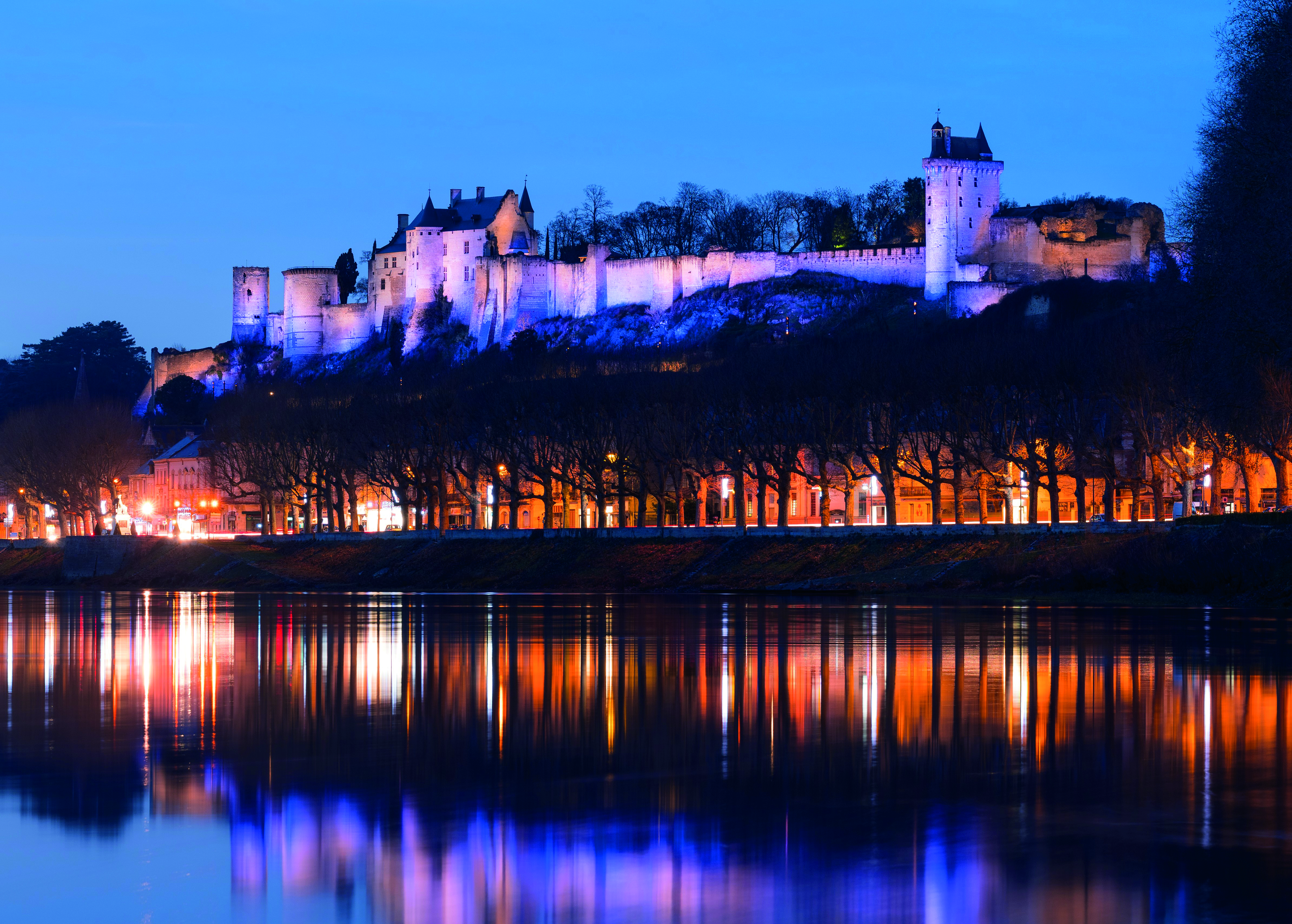
The Royal Fortress of Chinon, property of the Indre-et-Loire Departmental Council, is located on a natural promontory overlooking the Vienne River and the town of Chinon. It acquired its final configuration at the time of Charles VII. It was listed as Historic Monument in 1840. From the bridge that crosses the Vienne to the narrow passages of the old town, the streets of Chinon inevitably lead back to the foot of the fortress, as so many invitations to discover the charms of this site listed as World Heritage Site by UNESCO.
A pas de deux
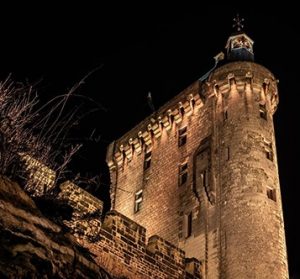
Christophe Canadell and Pascal Gougeon know each other well and work with light in a spirit of sobriety and softness. ‘We have the same approach to the site’s lighting concept: no flashy colours or bling bling effects!’ says Christophe Canadell. The context lends itself perfectly to this: no fewer than three architects are committed to the preserving of heritage… First, each designer develops his own ideas and then they bring them together to work on this atypical lighting which does not leave much freedom as to the implementation of the material. Their exchanges enrich the lighting design and lead to a project that defines a low-angle lighting on all the façades of the site. However, the lower parts of the rock are covered with shrubs that hide the walls of the building. Thanks to ‘ecograzing’, the sides of the fortress are ‘cleaned’ of this vegetation and the lighting can be implemented. Another difficulty arises: the Architecte des Bâtiments de France wants the light to come from above. ‘Given the configuration of the place and the nature of the building, it was difficult for us to install the fixtures on the walls themselves. Working as a duo allowed us to be persuasive. We were able to find the arguments to justify our choice and so a bottom-up lighting system was adopted,’ says Pascal Gougeon.
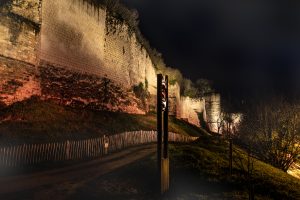
Low-angle lighting on poles
The question of the typology of the fixtures remained unresolved. There was no possibility of positioning spotlights on the stone: they would be too visible and there was significant risk of spilled light. The designers found the solution in creating a totem that supports several projectors (Lumenpulse). ‘These totem poles also allowed us to light the low wall. They were custom-sized, from 1.50 m to 7 m in height, and include from three to nine floodlights depending on the areas to be lit,’ explains Christophe Canadell. This arrangement underlines the relief and specific aspects of the fortress that were previously invisible. Camila Le Bertre, project manager, Noctabene, oversaw the technical development of the totems. They were manufactured by GHM and edited in a ‘Corten steel’ colour that allows them to blend into the landscape. They were erected on the south side of the site in place of the old masts of the previous lighting, as well as on the towpath and around the fortress for the west, east and north façades. ‘We planned an RGB system to give the castle the possibility of playing with colour. We designed the basic lighting in warm white for the top of thethe walls and colour is used for the base, which is the only place where the colours can be changed – red-amber for medieval celebrations and blue at Christmas,’ adds Pascal Gougeon.
Backlighting and guidance lighting at the castle
In some areas, such as the Clock Tower, the Dog Tower and the Royal Lodges, LED lights draw visitors’ attention to many architectural details. Backlit benches and integrated sound system for the tourist paths have been installed to offer tourists an innovative immersive experience. Finally, recessed ground lighting marks out the flow of the castle while illuminating the low walls in the castle’s courtyard.


